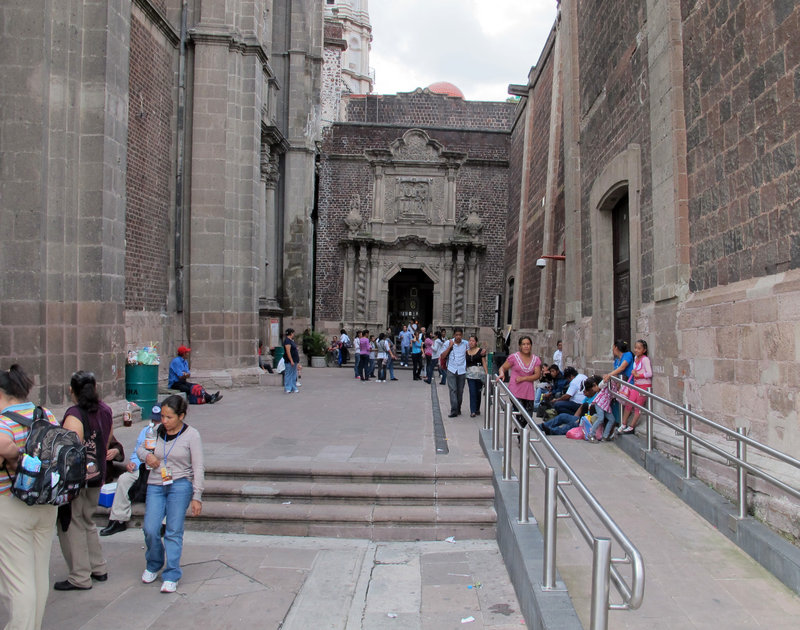MEXICO CITY – Walk into any of hundreds of homes or buildings in this huge capital, and you feel immediately that something is amiss. The buildings tilt.
“If you put a ball on the floor here,” Thierry Olivier said, sitting on the ground floor of his three-story building, “it will roll over there.”
By Olivier’s calculation, one corner of his 105-year-old building is 11 inches lower than the other. It lists like a tipsy cantina patron.
It’s a common phenomenon here, where many buildings are sinking, as each year Mexico City’s 21 million thirsty residents suck up water from the aquifer beneath one of the world’s largest metropolises. As the water level in the aquifer drops, the ground above it sinks.
But not evenly. Layers of soft clay beneath the city vary in thickness, and the ground sinks faster where clay dries out, grows brittle and collapses. That means that in some parts of the city, sidewalks buckle, window frames lean, subway lines need expensive repairs, and drainage canals no longer flow downhill.
As buildings turn and settle at a glacial pace, the humans who live in them also adjust, growing accustomed to living at a slight slope.
“You get used to everything,” Olivier said.
Engineers assert, however, that inhabitants face not only structural risks but also potential health problems as houses and apartment blocks incline.
“When a building tilts more than 1 degree, then I think it begins to become very uncomfortable,” said Enrique Santoyo Villa, an engineer who’s experienced at propping up and bolstering churches, monuments and other tilting structures.
By Santoyo’s standards, when a 100-foot-high building is 1 foot off its vertical axis, it becomes hard to live in. One notices it while lying in bed, he said, or perhaps washing the dishes and seeing tap water flow oddly.
“Tables aren’t stable. Liquids don’t look right when they are in big containers. … Window panes can break. Doors don’t close right,” Santoyo said.
Ancient Aztecs built the city of Tenochtitlan on an island in the middle of a large lake, making it the capital of their powerful empire. When Hernan Cortes and fellow conquistadors arrived in 1519 and conquered the Aztecs, the Spaniards built Mexico City atop the Aztec ruins, then drained much of the lake to control flooding.
Scores of colonial churches and other stone buildings in central Mexico City have survived frequent natural disasters but succumb to the soft clay underfoot, leaning or sinking into the ground.
Experts say parts of the metropolitan area have sunk by as much as 27 feet since the late 19th century, an average of 2.5 inches or so a year.
Some of the heaviest stone buildings, such as the opulent Palace of Fine Arts, have sunk 13 feet in a century. Its original ground floor is now a basement.
The tilt of other buildings is noticeable to the eye. A few list as a whole, while others, such as Mexico’s National Palace in the city’s Zocalo central square, undulate.
The city’s main cathedral and abutting Sagrario Church are a special case. The church is built partly atop the rigid remains of a giant pyramid to the Aztec sun god, so it sinks less than the larger cathedral.
The city has condemned 50 or so structures since 2006 because of leaning, and another 5,000 or so homes and buildings are unstable and at risk, said Oscar Alejandro Roa, the director of prevention at the city’s Civil Defense Bureau.
In some of the buildings, he said, “You have a permanent feeling of vertigo.”
Earthquakes are also a constant threat. A magnitude-8.1 quake in 1985 left some 10,000 people dead and caused at least 800 buildings to collapse.
Given constant tremors and subsiding soil, engineering and architectural firms in the capital make a steady living off bolstering buildings.
“This building was leaning against the other one,” Raul Jimenez, a building administrator, said outside one seven-story apartment block. “They dug down and filled the foundation with more concrete. … A lot of the buildings around here are crooked.”
Send questions/comments to the editors.



Success. Please wait for the page to reload. If the page does not reload within 5 seconds, please refresh the page.
Enter your email and password to access comments.
Hi, to comment on stories you must . This profile is in addition to your subscription and website login.
Already have a commenting profile? .
Invalid username/password.
Please check your email to confirm and complete your registration.
Only subscribers are eligible to post comments. Please subscribe or login first for digital access. Here’s why.
Use the form below to reset your password. When you've submitted your account email, we will send an email with a reset code.